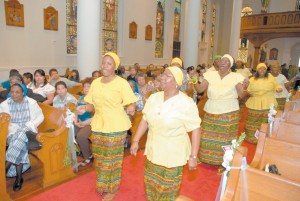Garifunas, yet another spice in New Orleans’ melting pot
26th October 2015 · 0 Comments
By Allana Barefield
Contributing Writer
Every culture has its own values, traditions, and beliefs that make it unique.
New Orleans, truly a melting pot of various ethnicities and cultures, is home to one of the diaspora populations of Garífunas who originated from Central America and are an ethnic mix of West African, Caribbean Carib Indians and Arawaks.
Migrating to New Orleans since the 1960’s, the Garífunas are often initially mistaken as African Americans. But the group continues to distinguish itself through speaking a Spanish dialect and by yearly traditions like the annual Misa Garífuna or Garifuna Mass that takes place each November. With the Annual Mass slated for November 15, 12 noon at Blessed Francis Xavier Seelos Church, the Garifuna traditions are particularly important 10 years after Hurricane Katrina scattered the New Orleans enclave of Garifunas to form a new community in Houston.
“I have believed for a long time that this vibrant and richly traditional community should be known throughout New Orleans, especially by departments of languages in the local universities and others who study Spanish and Latin America,” said Dr. Susan Spillman, an associate professor of French at Xavier University. Xavier’s traditions, like those of the Garifunas, are uniquely Black and Catholic, Spillman said. This is one of the reasons the university has developed a relationship of mutual interest and cooperation with the Garífunas, Spillman added.
The Garifunas’ traditions were recognized on Oct. 23, 2015 as part of Folklife Month events across the state. The event that featured a discussion on Garifuna language, music and dance was held on Xavier’s campus and organized by Xavier’s Modern Languages Department and its Division of Fine Arts and Humanities, along with the Louisiana Folklife Commission and the State Library. The Garífunas first migrated to present-day St. Vincent in 1665. Today, about 98,000 Garifunas live in Honduras. Some of their traditions in Central America and in the city include sewing fabrics with their signature colors: yellow, black, and white. Garifuna families cook traditional food flavored with black pepper, basil, garlic, and coconut milk. They keep their heritage alive by re-telling stories about their ancestors to younger generations. At the Garifuna Mass, they decorate the Blessed Francis Xavier Seelos Catholic Church on Dauphine Street with woven baskets and fruit like coconuts, plantains and yucca. Women wear traditional dresses with head wraps. There is dancing, singing and then a feast.
The Xavier event was a continuation of the work the university began in 2003 when it received a $25,000 grant titled “Vibrant Culture Speaks” from the National Endowment for the Humanities. The grant provided Spillman with funds to study the New Orleans Garífuna population. The grant, which lasted three years, provided stipends for informants, technical support, and was used to purchase research materials. “Several of the young Garis told me that they self-identify as African-American in school and with friends of North American origin, but as Garífuna when they are with their families,” Spillman said.
María Elena Zúñiga said she is proud to be Garifuna. She grew up in Honduras and after Hurricane Katrina in 2005 came to New Orleans. “My culture does not change anything, I feel good about who I am,” said Zúñiga, who is one of the organizers for the annual Garifuna Mass. She wanted to have the opportunity to inform the Xavier students about her heritage. “My culture traces to the origins of Carib Indians, Arawaks, the West Coast of Africa and Nigerians,” Zúñiga explained. The drums makes every song come alive to discuss concerns of the world, Zúñiga said. “The food, music, dance makes me who I am today, this culture is my identity,” Zúñiga added.
“I always had an affinity about immersing myself in new culture,” Adrina Stevenson said. “Although Xavier is a majority of African Americans, there is a diversity among the people. My peers come from all around the world, meaning that they have backgrounds which makes each individual different,” she said.
This article originally published in the October 26, 2015 print edition of The Louisiana Weekly newspaper.



